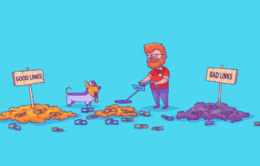Most people want to write a book, but few actually do, and that’s not a surprise to most of us. Of those who do become authors, very few go on to write books that sell more than a handful of copies. Why is this?

For over a century now, the concept of the bestseller has captivated writers, publishers, and even the general public. What makes a book a bestseller? And is this phenomenon a complete accident or the result of carefully executed marketing campaigns?
Maybe neither.
In this article, I want to share with you why the term “bestseller” needs to be reinvented, how I first failed at understanding this, and ultimately how to write a bestselling book.
But first, a story.
To listen to the audio version of this article, please click the player below (If you’re reading this via email, please click here).
How I failed to write a bestselling book
In 2013, I published my third book The In-Between, which was a memoir about the importance of being present to the little moments in life. It was a good book—my best work yet—but ended up being my worst-selling book.
Let’s back up a bit.
In 2012, I had published two books within a few months of each other. The first was a self-published eBook which sold over 10,000 copies in the first month, and the second was a trade paperback that had sold about 20,000 copies in the first six months.
After that, I decided to write something serious, something that would establish me as an important literary figure: a memoir. Why memoir? Who knows. I enjoyed reading memoirs at the time, so it just seemed like the thing to do. I hired an outside editor to help me with the book and commissioned an artist friend, Mandy Thompson, to illustrate each chapter with a drawing. The book was a work of art.
When it was released, the book sold 750 copies in the first month. Not only was it not a bestseller; it was a dismal failure. And the worst part was I had no idea why.
I thought I’d done everything I could do to make this book a success, and yet it wasn’t. I’d only grown my platform since my first two books, and both had easily outsold my latest work. And yet, here we were. The whole experience confused me. Was this how the world rewards important work? Had I already peaked—in the second year of my career as an author? Was I never going to have a best-selling book?
I didn’t know, and that feeling of helplessness frustrated me.
When I get frustrated, I become even more driven, even more ambitious. I became determined to write a bestseller. So I buckled down, wrote the best book I could, invested every dollar the publisher gave me back into promoting the book, and marketed it like a madman.
My fourth book, The Art of Work, sold 15,000 pre-orders before it even came out, landing it on the Washington Post, Publisher’s Weekly, and USATODAY bestsellers lists. The book went on to sell over 50,000 copies that first year. But it never hit the New York Times Bestsellers list—the big list that everyone cares about.
Guess how I felt? Like a failure. No matter how much I chased this elusive title of being a bestselling author, it seemed to evade me. Spurred on by my frustration, I did a little research. Turns out, the term “bestseller” has a more complicated history than I thought.
I thought being a bestselling author meant endless accolades and one chart-topping success after another, which is what I thought I wanted and where I believed I was headed. But it doesn’t mean that at all.
What is a bestseller?
Over the years, the term bestseller has carried with it many meanings.
At one point, it meant simply a book that sold better than most other books. This was a term that was applied to the works of Charles Dickens, Mark Twain, Jane Austen. Initially, most bestsellers were primarily works of fiction but over time it began to include more works of nonfiction, including the growing genre of self-help.
Later on, it was considered a pejorative term, suggesting a type of book that was of low literary value. As in, “there are great works of literature, and then there are… bestsellers.”
Today, the term usually means a book that has hit one of the major bestsellers lists, printed in the Washington Post, Wall Street Journal, USATODAY, New York Times, or Publisher’s Weekly.
What this means is that a book is one of the top-selling books of its kind for a given week, as reported by BookScan, which measures about 70% of book sales in America. There are also monthly lists, but most authors and publishers focus on the weekly lists.
An even newer development of the term is the mysterious “Amazon bestseller,” which means a book that has hit one of the many Amazon bestsellers lists, of which there are hundreds if not thousands.
These lists are updated hourly, so if you are able to move a decent number of copies of books in an hour, it’s not unlikely to hit a list for an hour and then lose that spot later in the day.
In fact, one author did an experiment with that, photographing a picture of his foot, using it as the book cover, asking his friends to buy the book all at once, and become a #1 bestseller in a specific category.
So, what is a bestseller?
Nobody knows. And that’s a problem.
Redefining the term “bestseller”
Today, the term bestseller means a lot of different things to a lot of different people, depending on who you ask, and not all of these terms are helpful.
For example, you could sell 10,000 copies of your book in the first week of its publication and never sell another copy, and you would likely become a New York Times bestseller, a title that would belong to you forever.
On the other hand, you could sell 100,000 copies of your book by selling a couple hundred copies per week over the course of a decade and never be considered an official “bestseller.” That seems wrong.
Most book marketing experts believe that this way of thinking about best-selling books is at best outdated and at worst, misleading.
I agree.
So what should it mean to be a bestseller? I like the Merriam-Webster’s definition of the term: “an article (such as a book) whose sales are among the highest of its class.” The term bestseller ought to mean what it sounds like: a book that sells better than most other books. But what would that take?
Most publishing studies reveal that a new book, on average, will sell around 250 copies and no more than 2000 copies in its lifetime. Since this is what the majority of books do, then selling more than this amount would technically make your book a bestseller.
So that, I think, should be what we mean when we say “bestseller.” A book that has sold better than the rest of its kind.
Book launch scams that are best avoided
So now that we’ve defined what a true bestseller is, how do you write one
These days, there’s no shortage of people telling you what it takes to write a bestselling book. Some even promise to possess the secret sauce that it takes to become a bestseller, whether that’s by “hacking” the media, building a platform, or chasing some new marketing fad.
Everyone, it seems, is trying to convince you that it’s not only possible to become an author, but that you are entitled to write a bestseller. Personally, I don’t think everyone should write a book. That would be a lot of books to read, and as a reader who cares about good books, I don’t want to read just another book that fluffs up the author’s ego. I want to read a good book. You should want to write one, too.
This is the antithesis of advice being thrown around by gurus today, suggesting that anyone can be a bestselling author simply by writing a book, regardless of a person’s skill, and apply a handful of marketing hit a list. But here’s the truth: Before you launch a bestseller, you have to write one.
That is, you have to write a book worthy of selling thousands of copies. The average book sells a couple hundred copies in its first year and fizzles out after that, selling no more than a couple thousand copies in its lifetime. If you want to be different, you’re going to have to do something different.
Whether we agree on this as the standard for the term bestseller, I think we can all agree that this should be the goal of an author: to sell as many copies of your book as possible. To be a successful author, you can’t just write any old book. You have to write a book worth selling. And that’s a different process altogether. The standard advice for writers these days is to “just write a good book.” But what does that mean?
Over the years, I’ve studied the world’s most successful authors and applied their principles to my own writing journey. What I’ve discovered is a repeatable process for writing a great book that sells a thousands of copies year after year.
These days, when someone asks me how to launch a bestselling book, I tell them, “I can’t tell you how to launch a bestseller without telling you how to write one.”
How to write a bestseller
Several attempts have been made to crack the code on what makes a bestselling book, and a common conclusion is that mega best-selling books are often a surprise to both the publisher and the author.
Yet, when we look back at successful books, the traits they have in common often seem obvious. As an author interested in selling more than a handful of copies of my books, I’ve always tried to pay attention to those themes and see how I can apply them to my writing.
Over the years, I’ve personally learned crucial lessons on writing and marketing from bestselling like Tim Ferriss, Lysa Terkeurst, and Ryan Holiday whose books have sold in the millions, as well as marketing and publishing experts like Tim Grahl, Michael Hyatt, Chad Cannon, and Joel Miller.
After applying what I learned from these mentors to my own books, I began to develop a framework, which became the process I now use to teach my writing students in how to write a book that will sell. Here are five tips to set your book up for success so that it has a chance of becoming a bestseller.
- Start with a big idea. Bestsellers are built on a big idea. Not just some old thing regurgitated in a new way. It’s something fresh and interesting. You must find an idea that will get readers excited to pick up your book. This goes for fiction, nonfiction, advice, how-to, and memoir. A small idea for a book results in small sales. And a book idea, well, you get the picture. J.R.R. Tolkien spent years developing the languages upon which his entire world would later be built. Don’t neglect the importance of nailing a big idea before you begin writing. And don’t rush the research.
- Write with the audience in mind. Bestsellers are sticky. The book needs to be written in a way where it can be easily shared and talked about, because it touches on some universal theme. In other words, don’t just write a book for yourself. Stephen King says you write the first draft with the door closed and the second draft with the door open. That’s good protocol. I suggest following my Five Draft Method to get your book written well and quickly, while weaving your big idea throughout the book.
- Edit for clarity, not perfection. Bestsellers are clear. Take out all the clutter that distracts your reader from the true message. Editing is not about making the book grammatically perfect (if that were true, books would be typo free). Rather, it is the process of making your book into what it’s supposed to be. So every time you edit your work, ask yourself, “Is this helping what I’m trying to say, or hurting it?”
- Package your book to spread. Bestsellers are packaged to sell. The title, cover, and design are all optimized to help the message spread. The way people experience your book will affect how well the book sells and how far it spreads. Your goal is to not only get this thing into people’s hands; it’s to give them something they want to share. This includes the decisions you make regarding title, cover, artwork, and design. So when Austin Kleon partnered with Workman, a publisher that tends to publish short, illustrated gift books, and they translated a speech he did into a short, affordable, illustrated book called Steal Like an Artist, they were thinking about packaging.
- Never stop launching. Bestsellers are perennial. The bestselling books of all time typically didn’t come out the gates as immediate successes. But because of their timeless nature, they just kept selling.Book launches are great, but you’re going to need more than one big event to sell this thing. Understanding the three unique launch phases of a book will help you sell your first 1000 or so copies, but it won’t help you sell your next 10,000 or 100,000 copies. The best way to do that is to never stop launching. Which is exactly what Dr. Gary Chapman told me he did when I asked how he sold millions of copies of his book, The 5 Love Languages. Hal Elrod who self-published The Miracle Morning and has sold over a million copies said the same thing: you just have to keep talking about it for a long time.
Writing your own bestseller
Now, what?
Well, first, I hope you decide to reclaim the title bestseller from the scam artists and fakers and redefine it as a book that sells better than most other books.
Second, I hope you understand that to launch a bestseller, you have to write a bestseller. A book that is worthy of being sold to thousands of people.
And lastly, I hope you understand that writing a bestseller is just as much science as art, and you should at least be aware of the factors that make a best-selling book.
This was why I created my latest course Write a Bestseller—because I believe in books and care deeply about the writing process. But I also care about authors and want to see them succeed. This course is a mix of those two desires. It’s my approach to the process of writing a great book that will sell.
And if you’ve been struggling to write or even finish your book, then it may be time for a new approach. Over 80% of people want to write a book someday, but without a plan, most never will.
In this course, not only will you learn the steps it takes to write a great book. You’ll be able to publish your work with confidence, knowing you are setting it up for success instead of merely hoping people pay attention.
And you’ll have me as your guide to walk you through the entire process. To learn more about Write a Bestseller, click here.
What’s your idea for a bestselling book? Share in the comments.

from The Portfolio Life with Jeff Goins https://ift.tt/2LA0AQK
via
seo7



